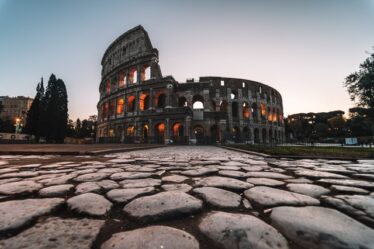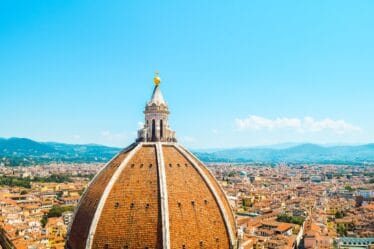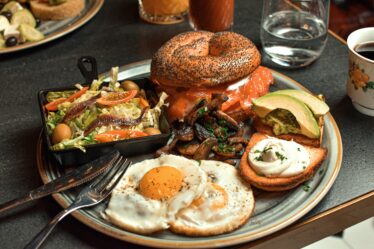
Here we have some tips for all our followers all people that want visit the city of Florence totally for free. We want remind that we are providing our free tour daily from Santa Maria Novella square meeting point next to the obelisk in front of Church facade.
Our free waking tour of Florence is totally free you don’t have pay anything if you don’t like.
The stones of Palazzo Pitti
Built in the second half of the fifteenth century at the behest of the banker Luca Pitti and then transformed into the main residence of the Medici family, Palazzo Pitti is one of the most famous buildings in Florence and today houses an important museum complex that ranges from modern art to porcelain.
Its imposing and austere facade also contains a detail that often escapes the eyes of visitors: on the ground floor, between the second and third openings to the left of the main entrance, one of the stones that make up the wall is visibly longer than the others. According to legend, this detail was commissioned by Luca Pitti himself, who in this way wanted to represent his superiority over all the other bankers in Florence.
The Lions of Florence
And speaking of protective animals, walking around Florence you will often come across lions. If in Venice and in the former territories of the Serenissima it is more than normal to spot one (in stone, of course), in other areas of Italy this is not the case. Florence, however, is an exception: here, in fact, it is easy to come across them – in the form of a statue, drawing, bas-relief or painting – very often seated and in the act of protecting the lily, the Florentine symbol.
More than a generic lion, however, we speak of Marzocco, a real totem animal for the city and adopted since the Middle Ages. The origin of its diffusion is uncertain: according to some, the lion is linked to the biblical tribe of Judah, of which it was a symbol; according to others, however, it would have been chosen to increasingly consolidate the relationship with the king of Scotland William I, known as “the Lion” (1143-1214), with whom the city had a strong political and commercial link.
Be that as it may, even if today the lions are all works of art, there was a time when they were alive and well in the city: in fact, in the fourteenth century, next to Palazzo Vecchio, the Signoria had a menagerie with about thirty animals locked up; today that street is called via dei Leoni.

The Gost of Baldaccio d’Anghiari
We remain in Piazza della Signoria for another of the legends of Florence: that of the ghost of Baldo by Piero Bruni, also known as Baldaccio d’Anghiari, a war hero born around 1400
Son of Assunta and Piero di Vagnone Bruni, procurator of the republic of Florence in the lands of Sorci: the ancestor Bruno, who lived two hundred years earlier, was a rich landowner and owner of the homonym castle, where the descendant will live with his wife. Baldo was born around 1400 (more probably in the last years of 1300) in Anghiari from an “ancient and honorable family”, he spent a turbulent youth during which he was tried several times. In particular, in 1420, together with some companions, he was sentenced to death for murder, but the sentence was not carried out because the defendants were not captured. For his physical prowess, fiery temper and bravado with friends he was immediately called Baldaccio. His prowess was mentioned by Machiavelli in the Florentine Histories:
and also celebrated by Niccolò Machiavelli, who called him most excellent in warfare, because in those times there was no one in Italy who surpassed him in virtue of body and mind”. It seems that in 1441, after falling into disgrace, Baldaccio was lured to Palazzo Vecchio by deception, stabbed to death by Bartolomeo Orlandini, a corrupt gonfaloniere, and then thrown from one of the windows of the building;as if that weren’t enough, he was finally beheaded in Piazza della Signoria.According to legend, his ghost still roams the halls of Palazzo Vecchio waiting for justice to be done. If you are coming her eduring the 31th of October is possible to here his moans.
The “boar ” brings good luck
Not far from Palazzo Vecchio is Piazza del Mercato Nuovo with the Loggia of the same name, a structure built between 1547 and 1551 and still today a place full of stalls of all kinds, with particular attention to leather goods.
However, the true protagonist of the place is the Fontana del Porcellino (which actually depicts a wild boar), one of the best-known monuments in Florence and one of the most famous lucky charms in the city. According to popular tradition, in fact, to attract a bit of good luck, you must first rub the animal’s nose and then place a coin in its mouth, on its tongue: if the coin, carried by the water, falls over the grate and ends up in the slot, luck is assured. There’s no harm in trying!

The Devil’s Riffle
Passing through via dello Studio, near the Duomo, you can feel a light breeze, a breeze called by the Florentines: the devil’s rifrullo.Legend has it that in ancient times a devil intended to take the soul of a priest.After chasing him far and wide through all the streets of the city, he finally managed to corner him right in front of the Duomo.The religious begged him to let him pray in church one last time before being damned, and the devil agreed. Taking courage, the priest took the opportunity to escape through one of the rear doors of the Cathedral.The devil waited for hours puffing and, when he realized the deception, the puff turned into a wind that still doesn’t stop blowing today.
Every day we are organizing our free walking tour that starts form Santa Maria Novella square in front of the obelisk in front of church facade, so if you want come and discovers these secrets and others book here :https://www.florencefreetours.com/
We are very happy to have you with us and show the beauty of our city totally for free, because our Free Tour is for real original free tour of Florence.



